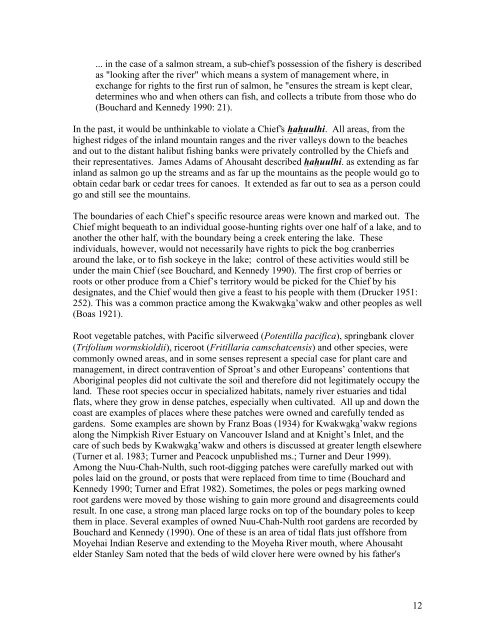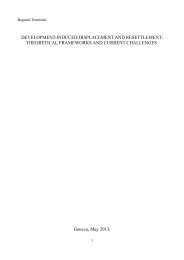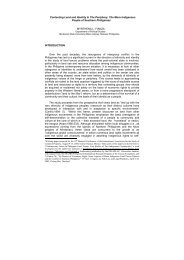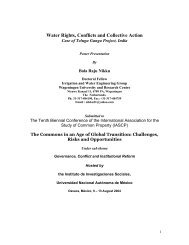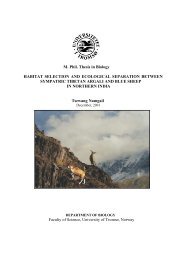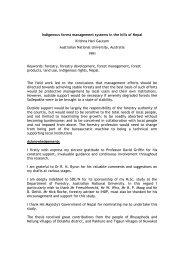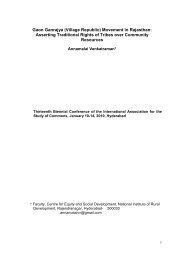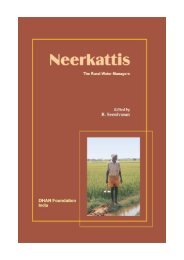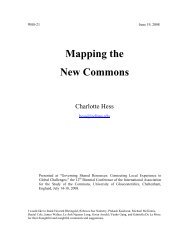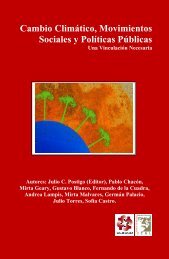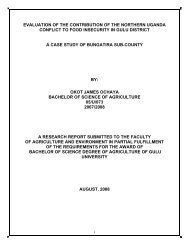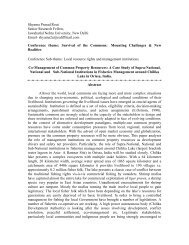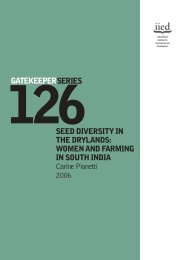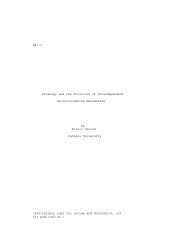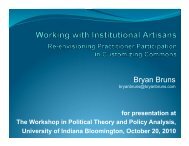Occupying the Land - Digital Library Of The Commons
Occupying the Land - Digital Library Of The Commons
Occupying the Land - Digital Library Of The Commons
Create successful ePaper yourself
Turn your PDF publications into a flip-book with our unique Google optimized e-Paper software.
... in <strong>the</strong> case of a salmon stream, a sub-chief’s possession of <strong>the</strong> fishery is describedas "looking after <strong>the</strong> river" which means a system of management where, inexchange for rights to <strong>the</strong> first run of salmon, he "ensures <strong>the</strong> stream is kept clear,determines who and when o<strong>the</strong>rs can fish, and collects a tribute from those who do(Bouchard and Kennedy 1990: 21).In <strong>the</strong> past, it would be unthinkable to violate a Chief’s hahuulhi. All areas, from <strong>the</strong>highest ridges of <strong>the</strong> inland mountain ranges and <strong>the</strong> river valleys down to <strong>the</strong> beachesand out to <strong>the</strong> distant halibut fishing banks were privately controlled by <strong>the</strong> Chiefs and<strong>the</strong>ir representatives. James Adams of Ahousaht described hahuulhi. as extending as farinland as salmon go up <strong>the</strong> streams and as far up <strong>the</strong> mountains as <strong>the</strong> people would go toobtain cedar bark or cedar trees for canoes. It extended as far out to sea as a person couldgo and still see <strong>the</strong> mountains.<strong>The</strong> boundaries of each Chief’s specific resource areas were known and marked out. <strong>The</strong>Chief might bequeath to an individual goose-hunting rights over one half of a lake, and toano<strong>the</strong>r <strong>the</strong> o<strong>the</strong>r half, with <strong>the</strong> boundary being a creek entering <strong>the</strong> lake. <strong>The</strong>seindividuals, however, would not necessarily have rights to pick <strong>the</strong> bog cranberriesaround <strong>the</strong> lake, or to fish sockeye in <strong>the</strong> lake; control of <strong>the</strong>se activities would still beunder <strong>the</strong> main Chief (see Bouchard, and Kennedy 1990). <strong>The</strong> first crop of berries orroots or o<strong>the</strong>r produce from a Chief’s territory would be picked for <strong>the</strong> Chief by hisdesignates, and <strong>the</strong> Chief would <strong>the</strong>n give a feast to his people with <strong>the</strong>m (Drucker 1951:252). This was a common practice among <strong>the</strong> Kwakwaka’wakw and o<strong>the</strong>r peoples as well(Boas 1921).Root vegetable patches, with Pacific silverweed (Potentilla pacifica), springbank clover(Trifolium wormskioldii), riceroot (Fritillaria camschatcensis) and o<strong>the</strong>r species, werecommonly owned areas, and in some senses represent a special case for plant care andmanagement, in direct contravention of Sproat’s and o<strong>the</strong>r Europeans’ contentions thatAboriginal peoples did not cultivate <strong>the</strong> soil and <strong>the</strong>refore did not legitimately occupy <strong>the</strong>land. <strong>The</strong>se root species occur in specialized habitats, namely river estuaries and tidalflats, where <strong>the</strong>y grow in dense patches, especially when cultivated. All up and down <strong>the</strong>coast are examples of places where <strong>the</strong>se patches were owned and carefully tended asgardens. Some examples are shown by Franz Boas (1934) for Kwakwaka’wakw regionsalong <strong>the</strong> Nimpkish River Estuary on Vancouver Island and at Knight’s Inlet, and <strong>the</strong>care of such beds by Kwakwaka’wakw and o<strong>the</strong>rs is discussed at greater length elsewhere(Turner et al. 1983; Turner and Peacock unpublished ms.; Turner and Deur 1999).Among <strong>the</strong> Nuu-Chah-Nulth, such root-digging patches were carefully marked out withpoles laid on <strong>the</strong> ground, or posts that were replaced from time to time (Bouchard andKennedy 1990; Turner and Efrat 1982). Sometimes, <strong>the</strong> poles or pegs marking ownedroot gardens were moved by those wishing to gain more ground and disagreements couldresult. In one case, a strong man placed large rocks on top of <strong>the</strong> boundary poles to keep<strong>the</strong>m in place. Several examples of owned Nuu-Chah-Nulth root gardens are recorded byBouchard and Kennedy (1990). One of <strong>the</strong>se is an area of tidal flats just offshore fromMoyehai Indian Reserve and extending to <strong>the</strong> Moyeha River mouth, where Ahousahtelder Stanley Sam noted that <strong>the</strong> beds of wild clover here were owned by his fa<strong>the</strong>r's12


